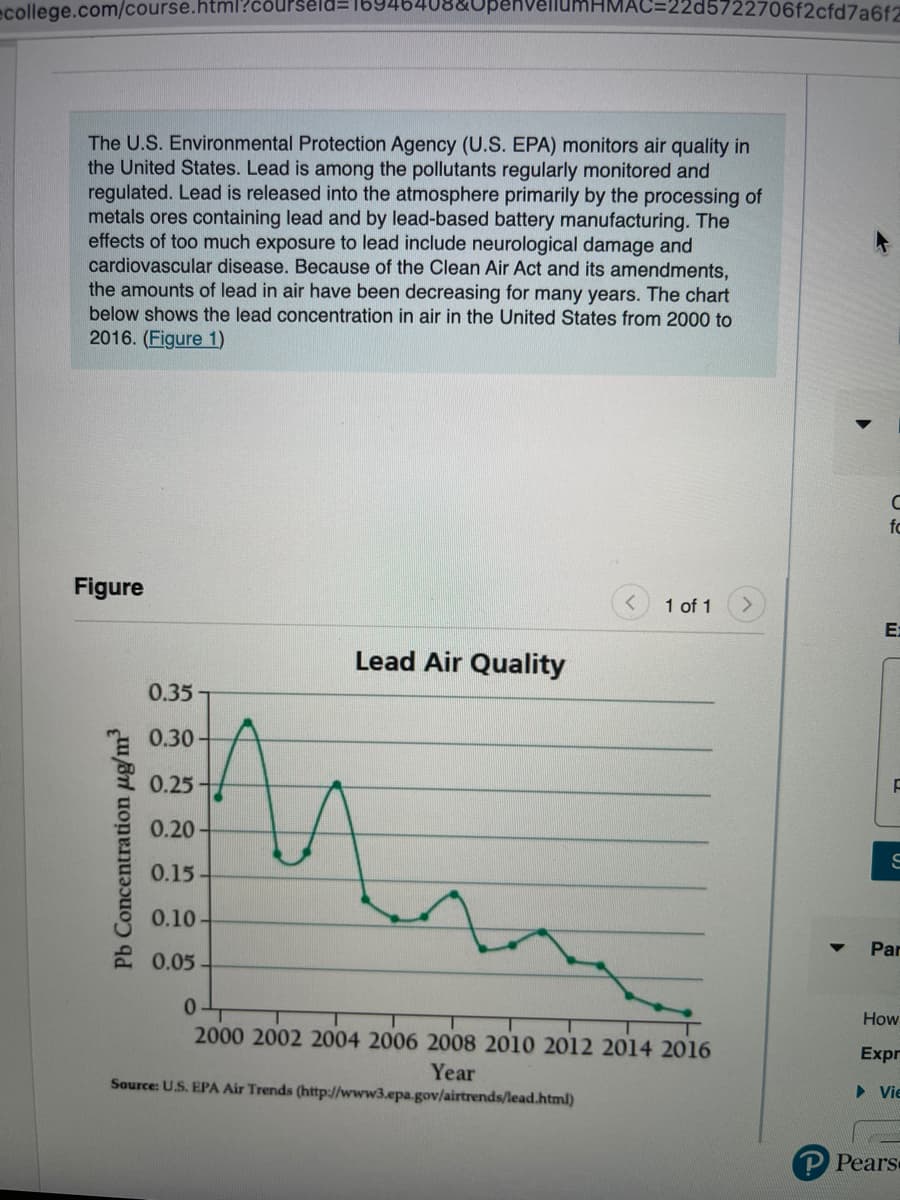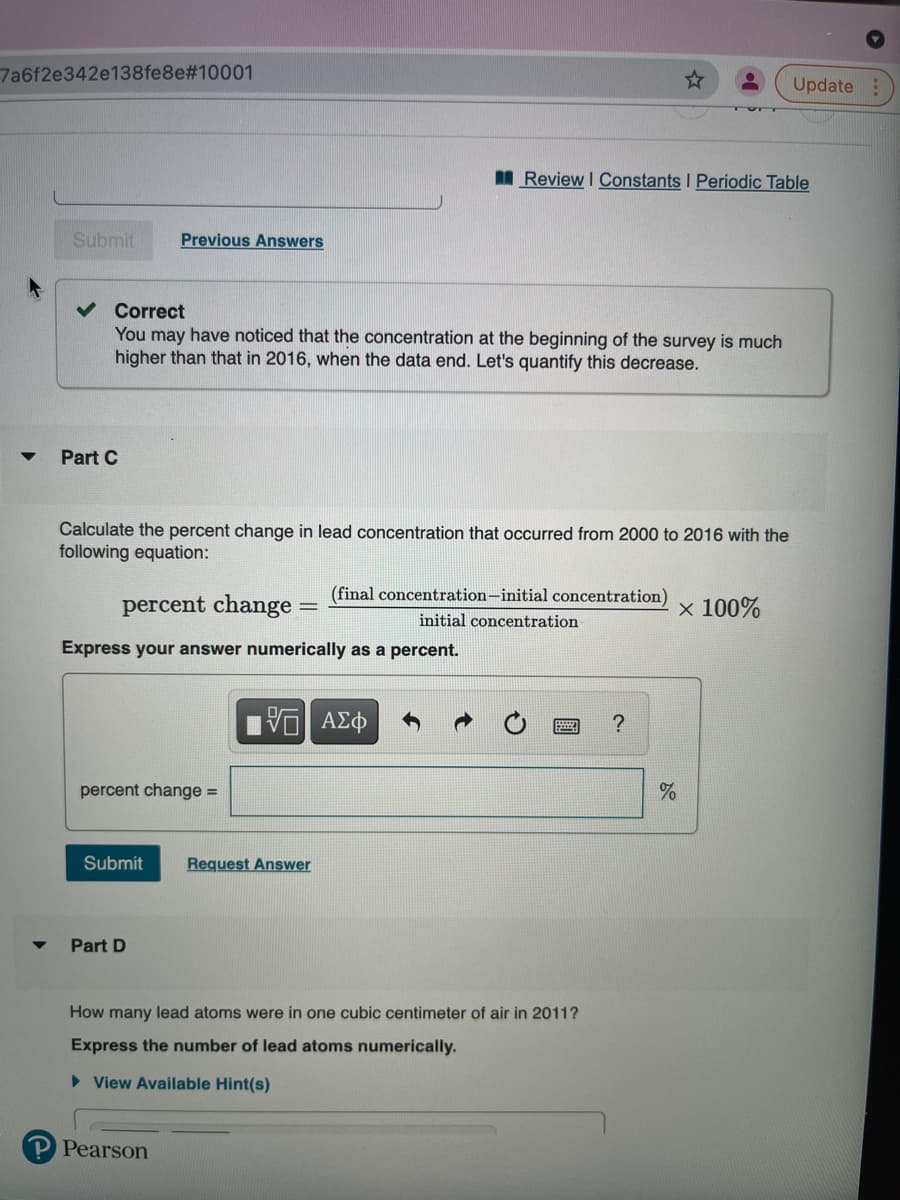Calculate the percent change in lead concentration that occurred from 2000 to 2016 with the following equation: (final concentration-initial concentration) percent change : x 100% initial concentration Express your answer numerically as a percent.
Calculate the percent change in lead concentration that occurred from 2000 to 2016 with the following equation: (final concentration-initial concentration) percent change : x 100% initial concentration Express your answer numerically as a percent.
Chemistry: The Molecular Science
5th Edition
ISBN:9781285199047
Author:John W. Moore, Conrad L. Stanitski
Publisher:John W. Moore, Conrad L. Stanitski
Chapter8: Properties Of Gases
Section: Chapter Questions
Problem 95QRT
Related questions
Question
Need help with part C

Transcribed Image Text:ecollege.com/course.html?čðurseld=
UpenvellumHMAC=22d5722706f2cfd7a6fZ
The U.S. Environmental Protection Agency (U.S. EPA) monitors air quality in
the United States. Lead is among the pollutants regularly monitored and
regulated. Lead is released into the atmosphere primarily by the processing of
metals ores containing lead and by lead-based battery manufacturing. The
effects of too much exposure to lead include neurological damage and
cardiovascular disease. Because of the Clean Air Act and its amendments,
the amounts of lead in air have been decreasing for many years. The chart
below shows the lead concentration in air in the United States from 2000 to
2016. (Figure 1)
fc
Figure
1 of 1
E:
Lead Air Quality
0.35
E 0.30-
0.25
0.20
0.15
0.10-
Par
2 0.05
0.
How
2000 2002 2004 2006 2008 2010 2012 2014 2016
Expr
Year
Source: U.S. EPA Air Trends (http://www3.epa.gov/airtrends/lead.html)
> Vie
P Pears
Pb Concentration ug/m

Transcribed Image Text:7a6f2e342e138fe8e#10001
Update :
I Review I Constants I Periodic Table
Submit
Previous Answers
Correct
You may have noticed that the concentration at the beginning of the survey is much
higher than that in 2016, when the data end. Let's quantify this decrease.
Part C
Calculate the percent change in lead concentration that occurred from 2000 to 2016 with the
following equation:
(final concentration-initial concentration)
percent change
x 100%
initial concentration
Express your answer numerically as a percent.
percent change =
Submit
Request Answer
Part D
How many lead atoms were in one cubic centimeter of air in 2011?
Express the number of lead atoms numerically.
• View Available Hint(s)
P Pearson
Expert Solution
This question has been solved!
Explore an expertly crafted, step-by-step solution for a thorough understanding of key concepts.
This is a popular solution!
Trending now
This is a popular solution!
Step by step
Solved in 2 steps

Recommended textbooks for you

Chemistry: The Molecular Science
Chemistry
ISBN:
9781285199047
Author:
John W. Moore, Conrad L. Stanitski
Publisher:
Cengage Learning

Chemistry for Engineering Students
Chemistry
ISBN:
9781337398909
Author:
Lawrence S. Brown, Tom Holme
Publisher:
Cengage Learning

Chemistry
Chemistry
ISBN:
9781305957404
Author:
Steven S. Zumdahl, Susan A. Zumdahl, Donald J. DeCoste
Publisher:
Cengage Learning

Chemistry: The Molecular Science
Chemistry
ISBN:
9781285199047
Author:
John W. Moore, Conrad L. Stanitski
Publisher:
Cengage Learning

Chemistry for Engineering Students
Chemistry
ISBN:
9781337398909
Author:
Lawrence S. Brown, Tom Holme
Publisher:
Cengage Learning

Chemistry
Chemistry
ISBN:
9781305957404
Author:
Steven S. Zumdahl, Susan A. Zumdahl, Donald J. DeCoste
Publisher:
Cengage Learning

Chemistry: An Atoms First Approach
Chemistry
ISBN:
9781305079243
Author:
Steven S. Zumdahl, Susan A. Zumdahl
Publisher:
Cengage Learning


Principles of Modern Chemistry
Chemistry
ISBN:
9781305079113
Author:
David W. Oxtoby, H. Pat Gillis, Laurie J. Butler
Publisher:
Cengage Learning